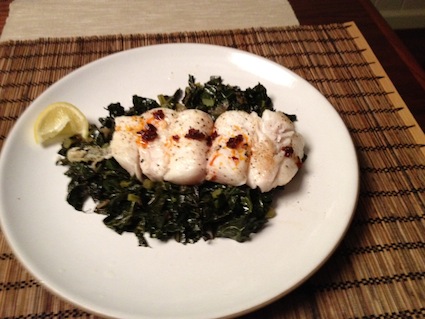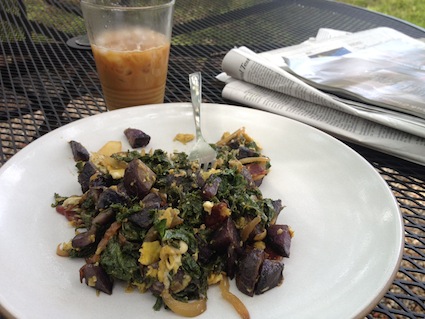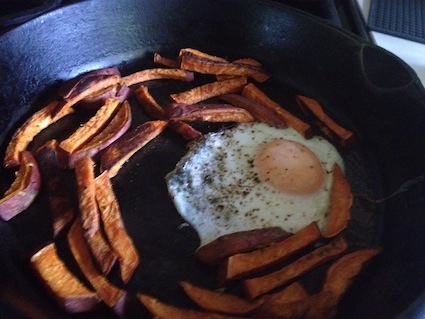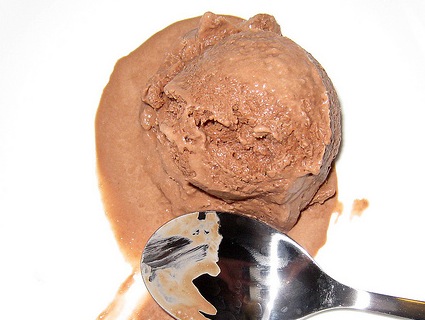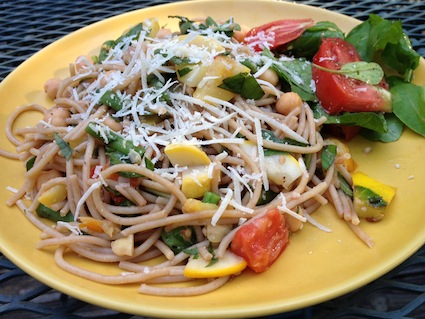
In Austin, where I grew up and where I’m spending time now, summer arrives with the subtlety of a two-by-four to the back of a head. You wake up one day, and suddenly its 95 degrees and humid—and not getting cooler until October. It’s barely June, and we’ve already crossed that threshold.
But I’ve noticed an important compensation for the brutal heat: Peak-season summer produce arrives early, too. In the high country of western North Carolina, where I’ve lived for years, we don’t start harvesting green beans, garlic, and squash until July, and tomatoes don’t come in until August. On a recent Saturday visit to Austin’s excellent inner-city Boggy Creek Farm, I was surprised to find all of that and more on display.
So I grabbed a bunch of it and did what I have done so often at Maverick Farms with similarly excellent produce: minimally cooked it and tossed it into a pasta, goosing it with chickpeas, walnuts, and Parmesan for a little extra flavor and protein.
Summer Veggie Pasta
2 handfuls slender green beans, such as haricot vert, stem end snapped off
Extra-virgin olive oil
Sea salt
3-4 small-to-medium summer squashes, trimmed at each end, quartered lengthwise and cut crosswise into quarter-inch wedges
3-4 cloves of garlic, minced fine
1-2 pinches red-hot chile flakes
3-4 ripe, plump tomatoes, coarsely chopped
1 good handful of basil leaves and and another of parsley leaves, chopped together
1 pound pasta (I used Bionaturae brand whole wheat spaghetti)
1/2 cup walnuts, lightly toasted and coarsely chopped
1 15 oz can chickpeas, drained (I’ve been using Eden Organic, which are BPA-free)
About a half cup freshly grated Parmigiano-Reggiano cheese, plus a block of same at table for grating
Coarsely ground black pepper
Steam the green beans until they’re barely tender but still have a good snap, using a steamer insert in a covered pan or whatever steaming method you have at hand. (Alternatively, you can drop them into boiling, salted water, taking great care not to let them overcook.) Remove the green beans into a colander and shock them with cold water to stop them from cooking. Set them aside on a cutting board, cut them into bite-sized pieces, and set aside.
Place a large skillet on the stovetop and turn heat to medium. Cover the bottom with olive oil, and when it’s hot, add the sliced squash along with a pinch of salt. Saute the squash, stirring frequently, for a minute or two. Add the garlic and chile flakes, and let them cook a minute or two, stirring. Now add the chopped tomatoes and another pinch of salt. Cook until the squash is just tender and the tomatoes are warmed through. What you will have in the pan will be pretty juicy. Resist the temptation to reduce away the tomato juices. If you do so, the squash will become very mushy. This dish is designed to celebrate the season’s first tomatoes, so I barely cook them and retain their juices as part of the sauce. Add the chickpeas, and remove pan from heat.
While you’re fussing over the sauté, prepare pasta using the great food science writer Harold McGee’s simple, radical, low-water, fast method (which generates a valuable pasta pot liquor that you’ll be adding to the skillet later).
Just before the pasta is done, add a ladle-full of the pasta water to the sautéed vegetables. Drain the pasta and return it to the now-empty pot you cooked it in. Dumped the sautéed vegetables on top of it, along with the cooked green beans, the toasted walnuts, and the chopped basil/parsley, and the grated Parmigiano-Reggiano. Add a good lashing of your best olive oil, and gently toss it all together. Taste. This dish is an excellent illustration of the power of good salting. If it seems bland, add a bit of salt, toss, and taste again, repeating as necessary, but taking care not to over-salt. You’ll note that when the salt reaches its proper level, the vegetables and herbs in the dish will emerge in their rightful vibrancy.
Serve, inviting people to grate extra cheese on their plates at table.

